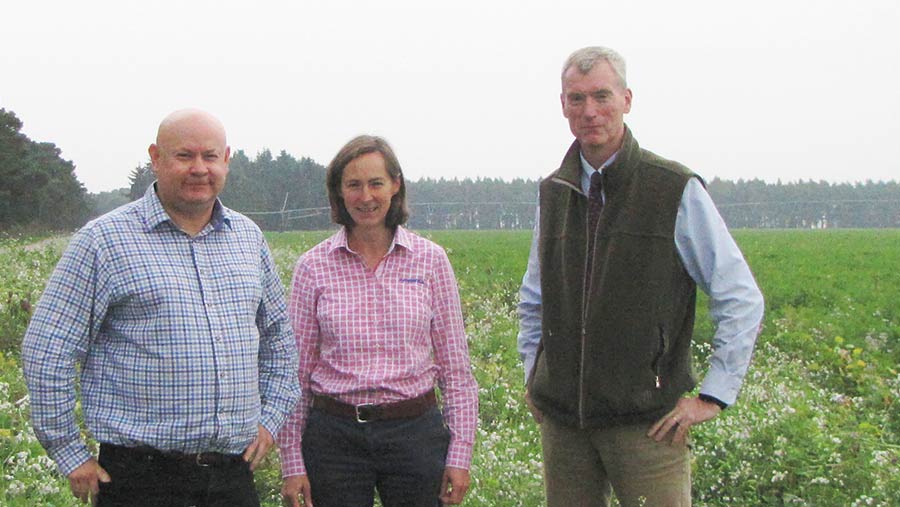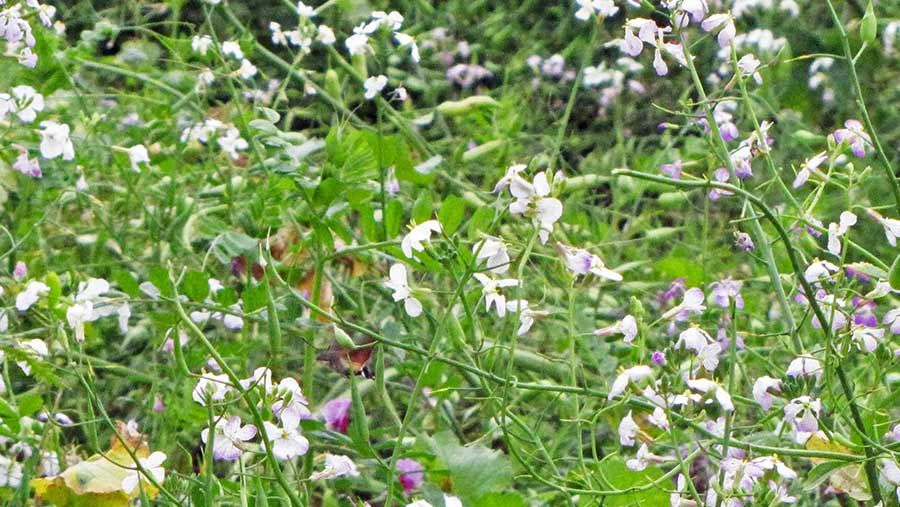Asda helps spud growers to go green
The headlands of potato fields can have a valuable role in promoting wildlife, and one major supermarket group is helping its spud growers to establish green covers on these areas.
Suffolk farm manager Andrew Francis opted to grow a green cover mix on the headlands of his potato, onion and carrot fields to create a valuable wildlife habitat and capture nutrients on the farm’s light soils.
He drilled the specially designed green crops on the headland across his Breckland estate at Elveden, near Thetford, with Asda part-funding the cost of the seed in conjunction with agrochemicals and seeds group Syngenta.
See also: Drip irrigating potatoes promises more crop per drop

Left to right: Andrew Francis, Belinda Bailey and Chris Brown © Louise Impey
More than 30 potato growers supplying the supermarket have taken up this scheme to turn unproductive headlands into areas that can help protect soil and water resources, while boosting wildlife.
Soil structure benefits
These headlands can still be used for turning machinery and irrigation equipment when sown with green crop mixes, and Mr Francis hopes that the process will help soil structures near the field boundaries.
“The green headlands look and feel right,” says Mr Francis. “The strips are alive with wildlife throughout the season and they help to capture any free moisture and nutrients from our vegetable crops.”
He established the 10m green covers in early June using a combination drill, and all bar one of them got going very well through the summer and autumn.
“We have tried other things with headlands, such as cropping some of them and having turning areas in the field, but we have had issues with indigenous weeds and soil consolidation,” he says.
Physical barrier
He is also wondering whether the dense canopy formed may act as a physical barrier to aphids and thrips, which can cause problems in his carrot and onion crops.

© Louise Impey
Nutrient capture by the headlands is another area of interest, as the farm’s light sandy soils don’t hold on to nutrients for any length of time.
“The headlands are easy to take out, by flailing, although we don’t yet know what will come up in following cereal crops,” says Mr Francis.
He is looking forward to receiving the feedback on what did and didn’t work, and is happy to have a go at this type of initiative. He notes that having a brassica element in the mix may encourage bean seed fly, which can cause damage in onions.
Ecologically sound
Any measure that is ecologically sound and practical to do is likely to be a good management tool for the farm, and if it was part of the farm’s Ecological Focus Area requirement, that would be even better, he says.
This green headland mix project is open to growers supplying IPL, which is the produce supplying arm of Asda.
The headlands are being independently monitored throughout the season, so that feedback on invertebrate numbers and diversity, as well as physical improvements to soils, is passed back to participating growers.
Replacing uncropped areas
Belinda Bailey, Syngenta’s environmental initiative manager, says the idea came from a desire to make better use of uncropped areas of land and demonstrate best practice.
“By and large, these areas on potato and root crop farms have traditionally been left as bare soil, so that machinery can turn and seasonal operations can continue unhampered,” she says.
Often these areas became infested with weeds and were susceptible to erosion and soil damage, and therefore had little or no ecological value.
“A pilot scheme run in 2016 with commercial farms showed that it could be successful. This year, we have seen over 100ha of the headland mix planted across over 30 farms,” she says.
Headland research
Chris Brown, director of sustainability and sourcing at Asda, explains that having green cover headlands is expected to bring clear benefits and he is keen to find out what they can deliver by supporting the growers.
“As a company we are committed to sustainability in everything that we do. Our customers care about environmental issues and expect Asda to be good stewards of production practices,” he says.
Mr Brown is eager to find out the true benefits of the scheme so the headland canopies are being sampled by an entomologist, pitfall traps are being used at ground level and soil samples are being analysed.
“We are putting some science behind this initiative. Of course, the headlands have tremendous visual appeal, but we believe they will have other positive outcomes,” he says.
Results from last year show that over 140 species of insects were found, including 41 species of pollinators, 29 species of known beneficial predators and 118 species of potential food sources for birds.
“It was a great start. We have started to validate the benefits of good practice,” he said.
Seed mix costs
The green headland mix is available to growers at a reduced cost of £35/ha and is sown at a rate of 20kg/ha. It contains five species – fodder radish, phacelia, berseem clover, buckwheat and vetch – although there is also a mix offered without the brassica element.
It has been developed by Syngenta and cover crop seed group Kings, so that it can be easily established and managed with minimal input. At present, the mix is not for use on Ecological Focus Areas or part of existing agri-environment schemes.

